Abstract
An autosomal dominant syndrome of prolactinomas, carcinoids, and hyperparathyroidism was described in four Newfoundland kindreds in 1980 and in one kindred from the Pacific Northwest in 1983. Because this syndrome shares many features with multiple endocrine neoplasia type 1, the gene for which maps to proximal chromosome 11q, we performed linkage studies with chromosome 11 markers in prolactinoma families to determine whether the two genes map to the same location. All proximal chromosome 11q markers gave positive LOD scores, and no recombinants were seen with PYGM (LOD score 15.25, recombination fraction .0). All affected individuals from Newfoundland shared the same PYGM allele, providing evidence for a founder effect. The disease in the Pacific Northwest kindred cosegregated with a different PYGM allele.
Full text
PDF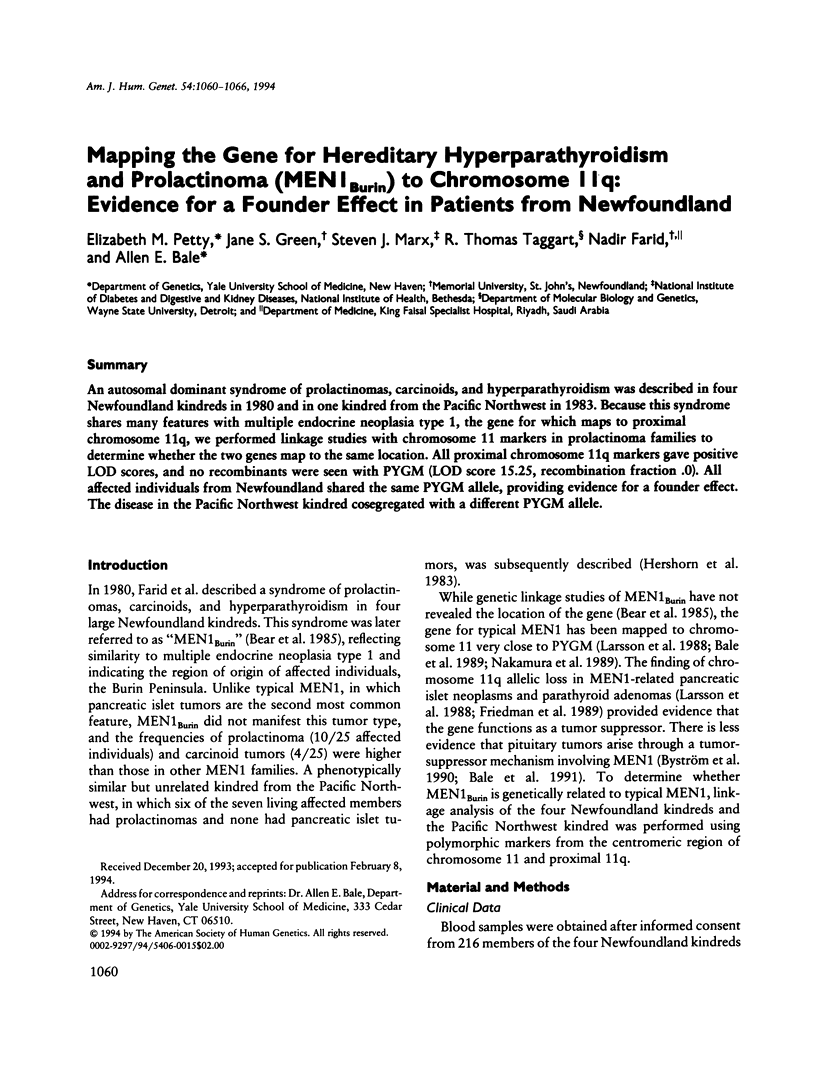
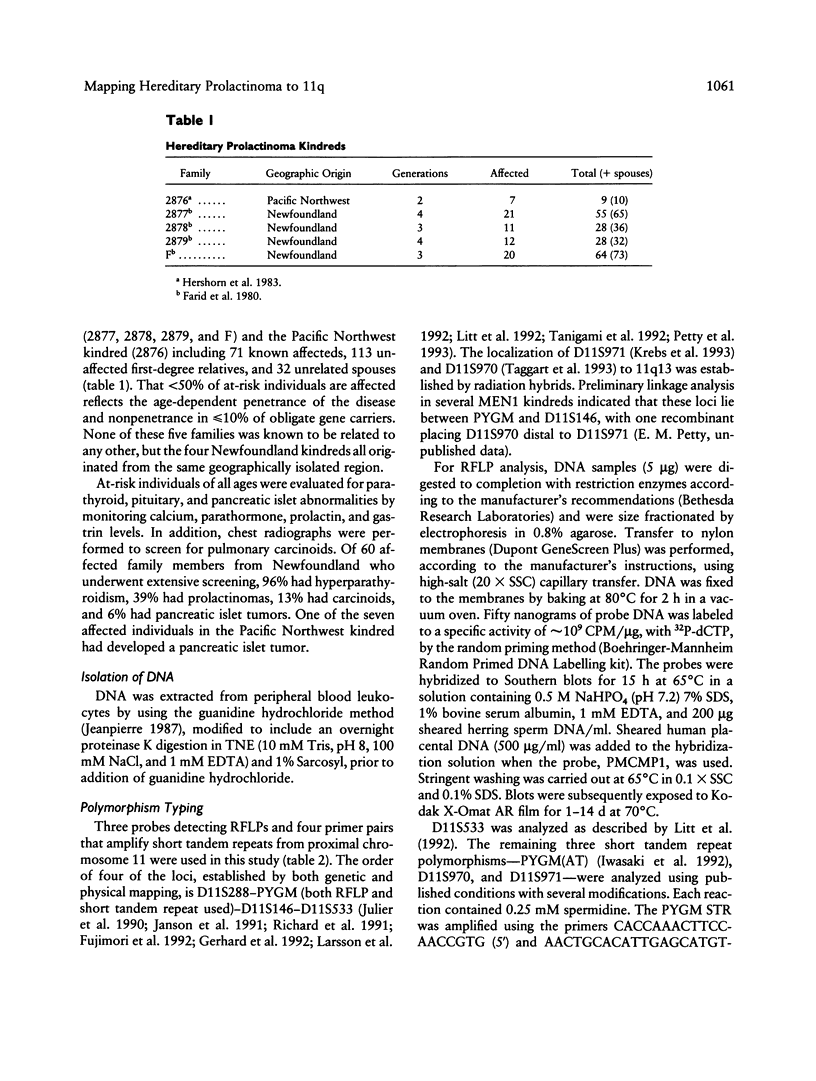
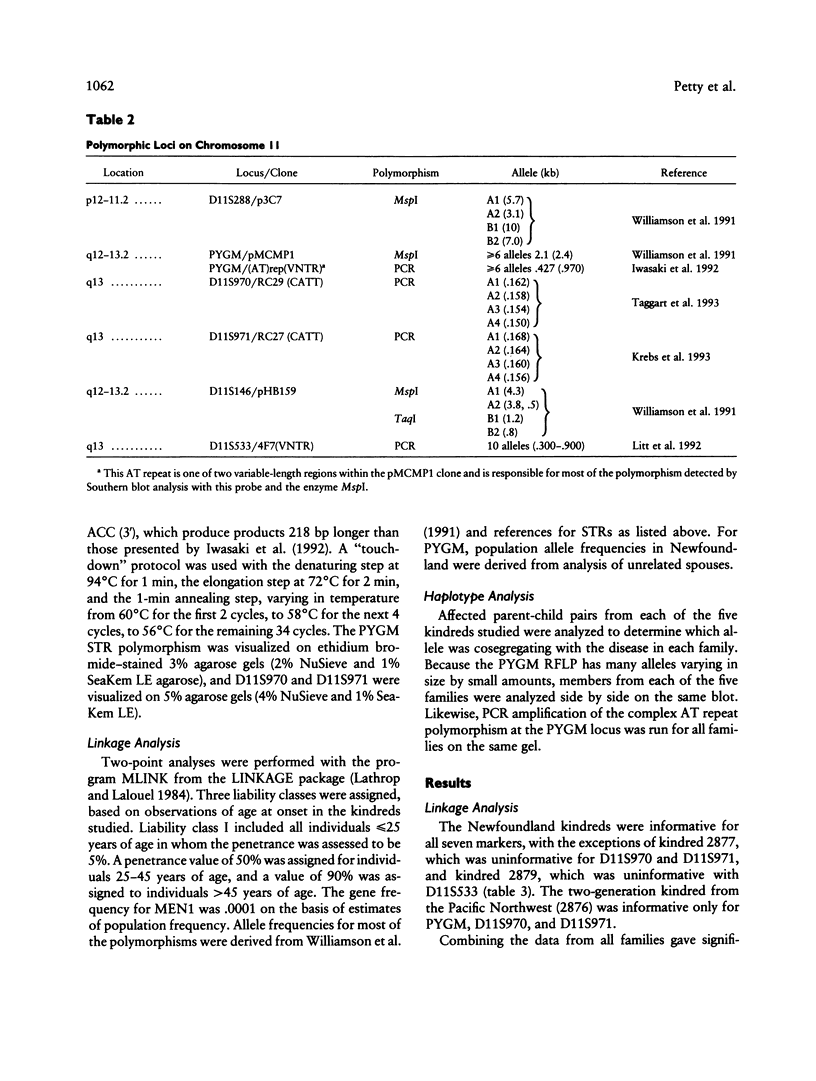
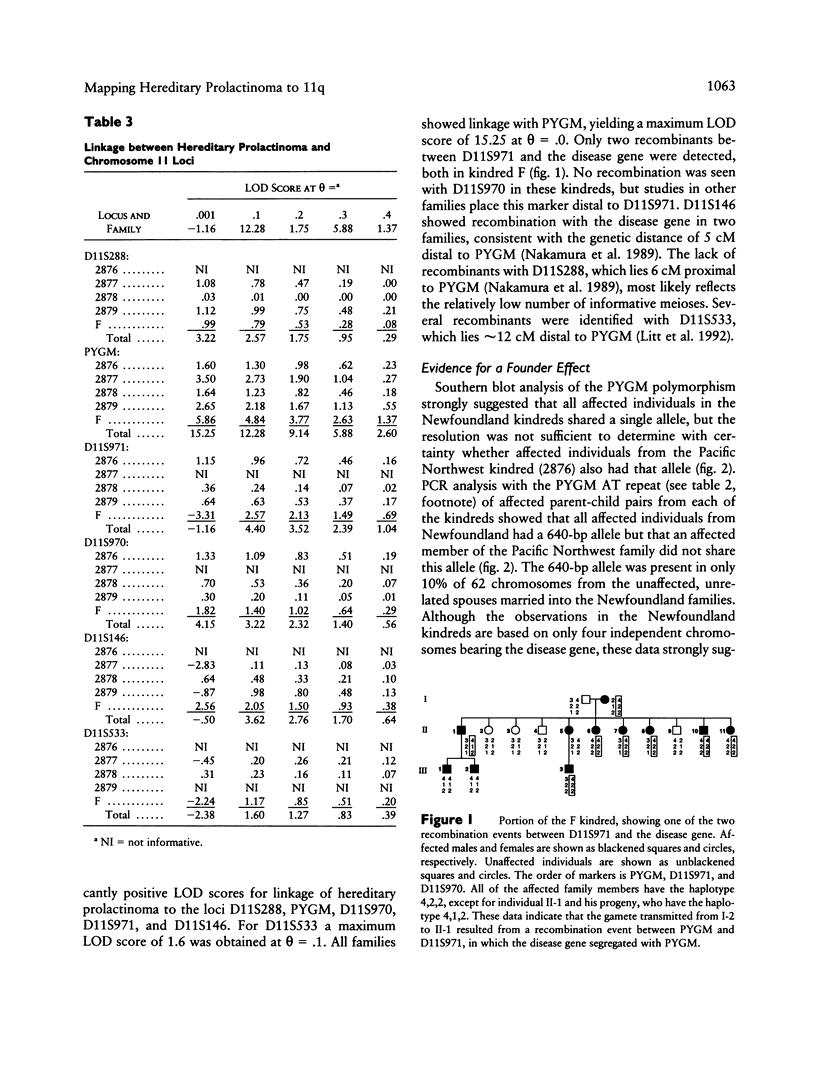
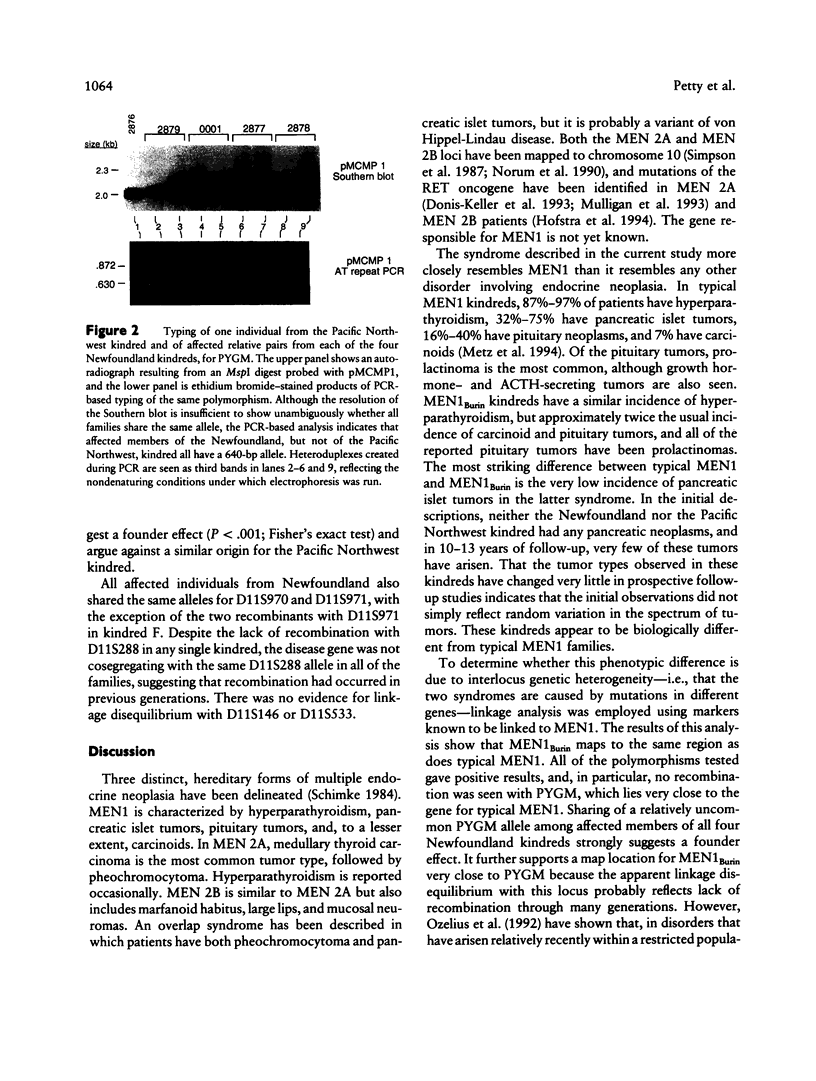
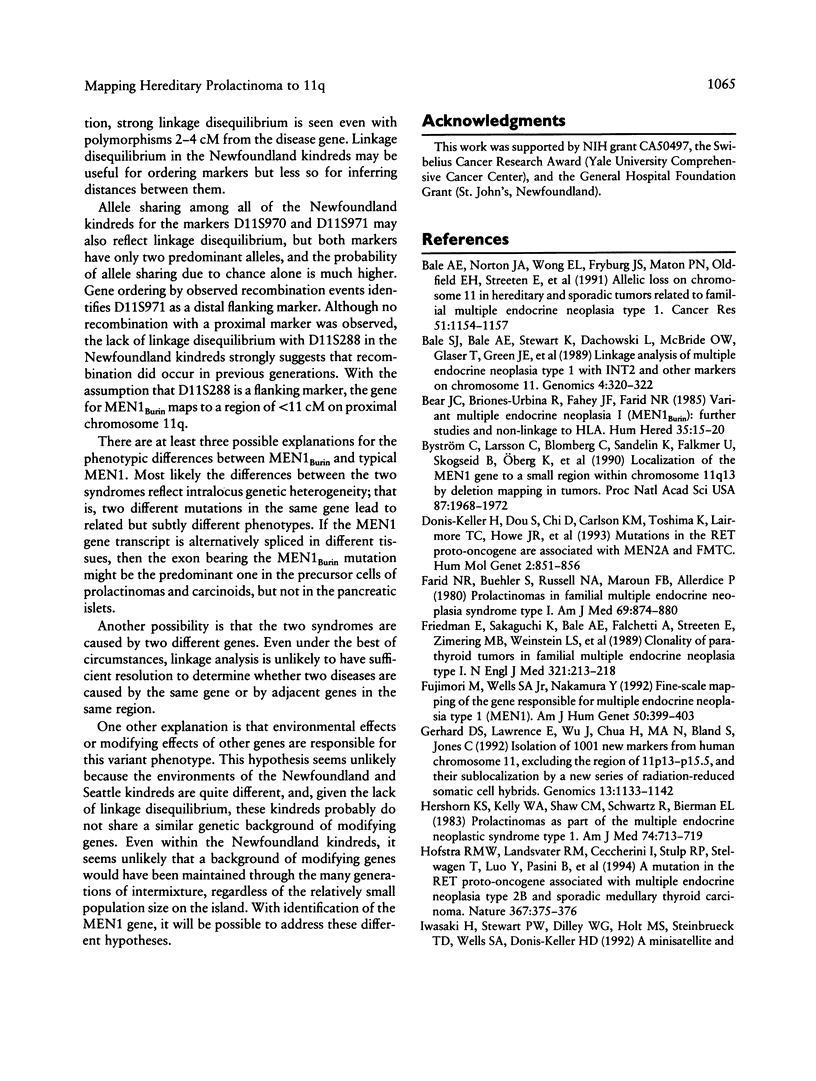
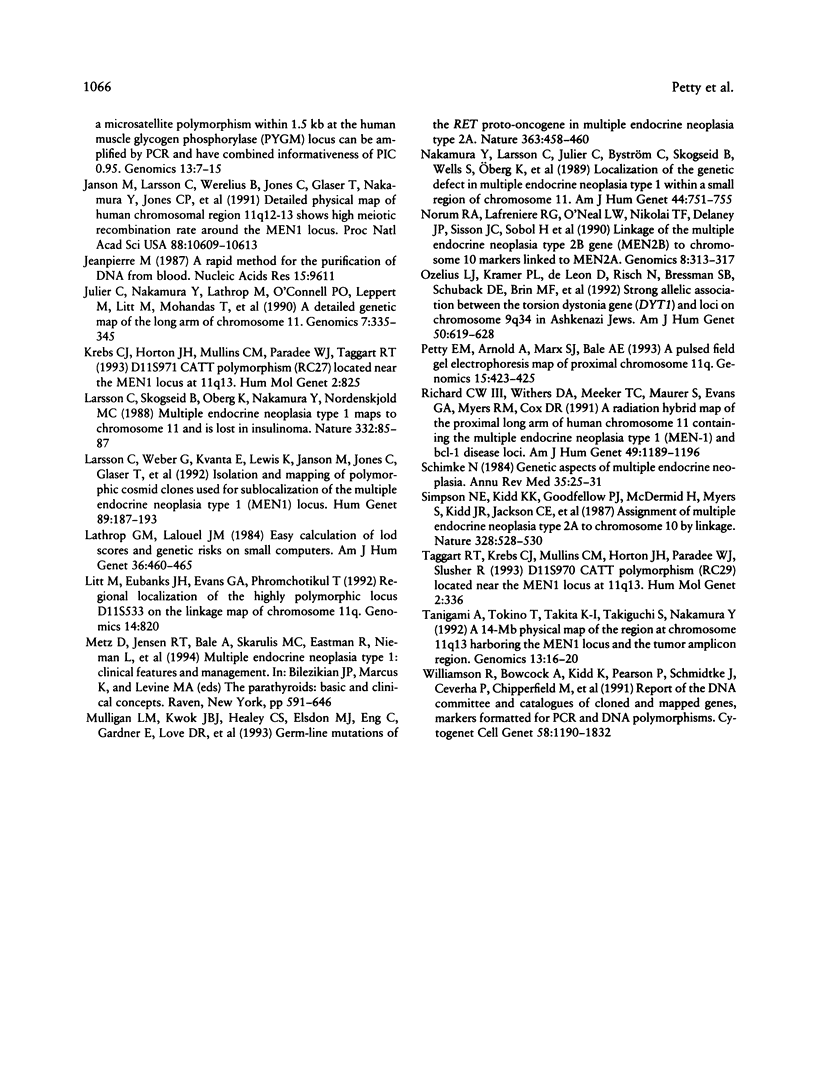
Images in this article
Selected References
These references are in PubMed. This may not be the complete list of references from this article.
- Bale A. E., Norton J. A., Wong E. L., Fryburg J. S., Maton P. N., Oldfield E. H., Streeten E., Aurbach G. D., Brandi M. L., Friedman E. Allelic loss on chromosome 11 in hereditary and sporadic tumors related to familial multiple endocrine neoplasia type 1. Cancer Res. 1991 Feb 15;51(4):1154–1157. [PubMed] [Google Scholar]
- Bale S. J., Bale A. E., Stewart K., Dachowski L., McBride O. W., Glaser T., Green J. E., 3rd, Mulvihill J. J., Brandi M. L., Sakaguchi K. Linkage analysis of multiple endocrine neoplasia type 1 with INT2 and other markers on chromosome 11. Genomics. 1989 Apr;4(3):320–322. doi: 10.1016/0888-7543(89)90336-4. [DOI] [PubMed] [Google Scholar]
- Bear J. C., Briones-Urbina R., Fahey J. F., Farid N. R. Variant multiple endocrine neoplasia I (MEN IBurin): further studies and non-linkage to HLA. Hum Hered. 1985;35(1):15–20. doi: 10.1159/000153508. [DOI] [PubMed] [Google Scholar]
- Byström C., Larsson C., Blomberg C., Sandelin K., Falkmer U., Skogseid B., Oberg K., Werner S., Nordenskjöld M. Localization of the MEN1 gene to a small region within chromosome 11q13 by deletion mapping in tumors. Proc Natl Acad Sci U S A. 1990 Mar;87(5):1968–1972. doi: 10.1073/pnas.87.5.1968. [DOI] [PMC free article] [PubMed] [Google Scholar]
- Donis-Keller H., Dou S., Chi D., Carlson K. M., Toshima K., Lairmore T. C., Howe J. R., Moley J. F., Goodfellow P., Wells S. A., Jr Mutations in the RET proto-oncogene are associated with MEN 2A and FMTC. Hum Mol Genet. 1993 Jul;2(7):851–856. doi: 10.1093/hmg/2.7.851. [DOI] [PubMed] [Google Scholar]
- Farid N. R., Buehler S., Russell N. A., Maroun F. B., Allerdice P., Smyth H. S. Prolactinomas in familial multiple endocrine neoplasia syndrome type I. Relationship to HLA and carcinoid tumors. Am J Med. 1980 Dec;69(6):874–880. doi: 10.1016/s0002-9343(80)80013-1. [DOI] [PubMed] [Google Scholar]
- Friedman E., Sakaguchi K., Bale A. E., Falchetti A., Streeten E., Zimering M. B., Weinstein L. S., McBride W. O., Nakamura Y., Brandi M. L. Clonality of parathyroid tumors in familial multiple endocrine neoplasia type 1. N Engl J Med. 1989 Jul 27;321(4):213–218. doi: 10.1056/NEJM198907273210402. [DOI] [PubMed] [Google Scholar]
- Fujimori M., Wells S. A., Jr, Nakamura Y. Fine-scale mapping of the gene responsible for multiple endocrine neoplasia type 1 (MEN 1). Am J Hum Genet. 1992 Feb;50(2):399–403. [PMC free article] [PubMed] [Google Scholar]
- Gerhard D. S., Lawrence E., Wu J., Chua H., Ma N., Bland S., Jones C. Isolation of 1001 new markers from human chromosome 11, excluding the region of 11p13-p15.5, and their sublocalization by a new series of radiation-reduced somatic cell hybrids. Genomics. 1992 Aug;13(4):1133–1142. doi: 10.1016/0888-7543(92)90028-q. [DOI] [PubMed] [Google Scholar]
- Hershon K. S., Kelly W. A., Shaw C. M., Schwartz R., Bierman E. L. Prolactinomas as part of the multiple endocrine neoplastic syndrome type 1. Am J Med. 1983 Apr;74(4):713–720. doi: 10.1016/0002-9343(83)91032-x. [DOI] [PubMed] [Google Scholar]
- Hofstra R. M., Landsvater R. M., Ceccherini I., Stulp R. P., Stelwagen T., Luo Y., Pasini B., Höppener J. W., van Amstel H. K., Romeo G. A mutation in the RET proto-oncogene associated with multiple endocrine neoplasia type 2B and sporadic medullary thyroid carcinoma. Nature. 1994 Jan 27;367(6461):375–376. doi: 10.1038/367375a0. [DOI] [PubMed] [Google Scholar]
- Iwasaki H., Stewart P. W., Dilley W. G., Holt M. S., Steinbrueck T. D., Wells S. A., Jr, Donis-Keller H. A minisatellite and a microsatellite polymorphism within 1.5 kb at the human muscle glycogen phosphorylase (PYGM) locus can be amplified by PCR and have combined informativeness of PIC 0.95. Genomics. 1992 May;13(1):7–15. doi: 10.1016/0888-7543(92)90194-w. [DOI] [PubMed] [Google Scholar]
- Janson M., Larsson C., Werelius B., Jones C., Glaser T., Nakamura Y., Jones C. P., Nordenskjöld M. Detailed physical map of human chromosomal region 11q12-13 shows high meiotic recombination rate around the MEN1 locus. Proc Natl Acad Sci U S A. 1991 Dec 1;88(23):10609–10613. doi: 10.1073/pnas.88.23.10609. [DOI] [PMC free article] [PubMed] [Google Scholar]
- Jeanpierre M. A rapid method for the purification of DNA from blood. Nucleic Acids Res. 1987 Nov 25;15(22):9611–9611. doi: 10.1093/nar/15.22.9611. [DOI] [PMC free article] [PubMed] [Google Scholar]
- Julier C., Nakamura Y., Lathrop M., O'Connell P., Leppert M., Litt M., Mohandas T., Lalouel J. M., White R. A detailed genetic map of the long arm of chromosome 11. Genomics. 1990 Jul;7(3):335–345. doi: 10.1016/0888-7543(90)90167-s. [DOI] [PubMed] [Google Scholar]
- Krebs C. J., Horton J. H., Mullins C. M., Paradee W. J., Taggart R. T. D11S971 CATT polymorphism (RC27) located near the MEN1 locus at 11q13. Hum Mol Genet. 1993 Jun;2(6):825–825. doi: 10.1093/hmg/2.6.825-a. [DOI] [PubMed] [Google Scholar]
- Larsson C., Skogseid B., Oberg K., Nakamura Y., Nordenskjöld M. Multiple endocrine neoplasia type 1 gene maps to chromosome 11 and is lost in insulinoma. Nature. 1988 Mar 3;332(6159):85–87. doi: 10.1038/332085a0. [DOI] [PubMed] [Google Scholar]
- Larsson C., Weber G., Kvanta E., Lewis K., Janson M., Jones C., Glaser T., Evans G., Nordenskjöld M. Isolation and mapping of polymorphic cosmid clones used for sublocalization of the multiple endocrine neoplasia type 1 (MEN1) locus. Hum Genet. 1992 May;89(2):187–193. doi: 10.1007/BF00217121. [DOI] [PubMed] [Google Scholar]
- Lathrop G. M., Lalouel J. M. Easy calculations of lod scores and genetic risks on small computers. Am J Hum Genet. 1984 Mar;36(2):460–465. [PMC free article] [PubMed] [Google Scholar]
- Litt M., Eubanks J. H., Evans G. A., Phromchotikul T. Regional localization of the highly polymorphic locus D11S533 on the linkage map of human chromosome 11q. Genomics. 1992 Nov;14(3):820–820. doi: 10.1016/s0888-7543(05)80199-5. [DOI] [PubMed] [Google Scholar]
- Mulligan L. M., Kwok J. B., Healey C. S., Elsdon M. J., Eng C., Gardner E., Love D. R., Mole S. E., Moore J. K., Papi L. Germ-line mutations of the RET proto-oncogene in multiple endocrine neoplasia type 2A. Nature. 1993 Jun 3;363(6428):458–460. doi: 10.1038/363458a0. [DOI] [PubMed] [Google Scholar]
- Nakamura Y., Larsson C., Julier C., Byström C., Skogseid B., Wells S., Oberg K., Carlson M., Taggart T., O'Connell P. Localization of the genetic defect in multiple endocrine neoplasia type 1 within a small region of chromosome 11. Am J Hum Genet. 1989 May;44(5):751–755. [PMC free article] [PubMed] [Google Scholar]
- Norum R. A., Lafreniere R. G., O'Neal L. W., Nikolai T. F., Delaney J. P., Sisson J. C., Sobol H., Lenoir G. M., Ponder B. A., Willard H. F. Linkage of the multiple endocrine neoplasia type 2B gene (MEN2B) to chromosome 10 markers linked to MEN2A. Genomics. 1990 Oct;8(2):313–317. doi: 10.1016/0888-7543(90)90287-5. [DOI] [PubMed] [Google Scholar]
- Ozelius L. J., Kramer P. L., de Leon D., Risch N., Bressman S. B., Schuback D. E., Brin M. F., Kwiatkowski D. J., Burke R. E., Gusella J. F. Strong allelic association between the torsion dystonia gene (DYT1) andloci on chromosome 9q34 in Ashkenazi Jews. Am J Hum Genet. 1992 Mar;50(3):619–628. [PMC free article] [PubMed] [Google Scholar]
- Petty E. M., Arnold A., Marx S. J., Bale A. E. A pulsed-field gel electrophoresis (PFGE) map of twelve loci on chromosome 11q11-q13. Genomics. 1993 Feb;15(2):423–425. doi: 10.1006/geno.1993.1080. [DOI] [PubMed] [Google Scholar]
- Richard C. W., 3rd, Withers D. A., Meeker T. C., Maurer S., Evans G. A., Myers R. M., Cox D. R. A radiation hybrid map of the proximal long arm of human chromosome 11 containing the multiple endocrine neoplasia type 1 (MEN-1) and bcl-1 disease loci. Am J Hum Genet. 1991 Dec;49(6):1189–1196. [PMC free article] [PubMed] [Google Scholar]
- Schimke R. N. Genetic aspects of multiple endocrine neoplasia. Annu Rev Med. 1984;35:25–31. doi: 10.1146/annurev.me.35.020184.000325. [DOI] [PubMed] [Google Scholar]
- Simpson N. E., Kidd K. K., Goodfellow P. J., McDermid H., Myers S., Kidd J. R., Jackson C. E., Duncan A. M., Farrer L. A., Brasch K. Assignment of multiple endocrine neoplasia type 2A to chromosome 10 by linkage. Nature. 1987 Aug 6;328(6130):528–530. doi: 10.1038/328528a0. [DOI] [PubMed] [Google Scholar]
- Taggart R. T., Krebs C. J., Mullins C. M., Horton J. H., Paradee W. J., Slusher R. D11S970 CATT polymorphism (RC29) located near the MEN1 locus at 11q13. Hum Mol Genet. 1993 Mar;2(3):336–336. doi: 10.1093/hmg/2.3.336. [DOI] [PubMed] [Google Scholar]
- Tanigami A., Tokino T., Takita K., Takiguchi S., Nakamura Y. A 14-Mb physical map of the region at chromosome 11q13 harboring the MEN1 locus and the tumor amplicon region. Genomics. 1992 May;13(1):16–20. doi: 10.1016/0888-7543(92)90195-x. [DOI] [PubMed] [Google Scholar]



